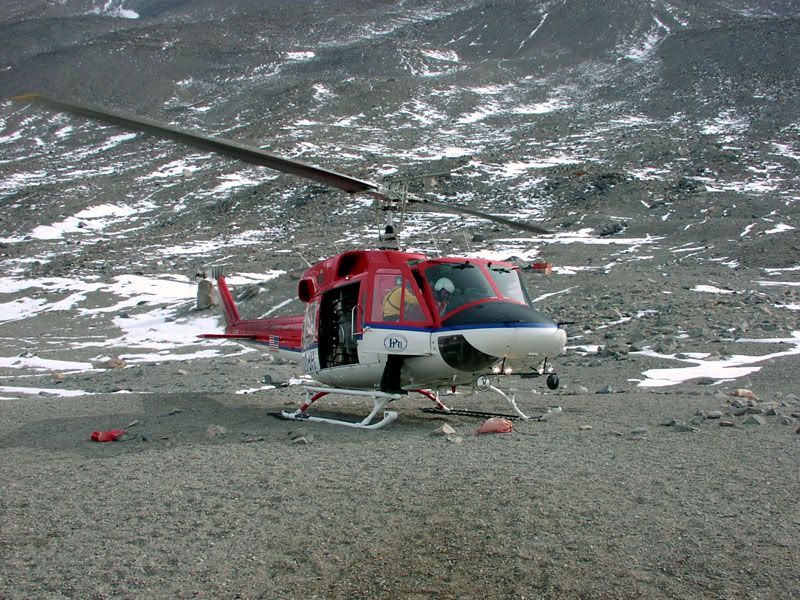You are using an out of date browser. It may not display this or other websites correctly.
You should upgrade or use an alternative browser.
You should upgrade or use an alternative browser.
McMurdo Dry Valleys LTER, Antarctica
- Thread starter Ducks
- Start date
Ducks
Adventurer
B212. This is the big helicopter. It brought us back and forth between McMurdo Station and our field camp with all of our gear. It also rescued us off of Commonwealth glacier. We had been dropped off in the morning by an A-Star in the accumulation zone of the glacier. Our guide, myself, and Thomas Nylen roped ourselves together as a precaution so we didn't fall into any hidden crevasses. We traveled around on snowshoes measuring the accumulation stakes on the glacier. In the afternoon, it started getting windy. By early evening, we were stuck in the middle of a huge blizzard. The A-Star couldn't come get us because it was too windy. We were 22 very rugged miles from our field camp and we could barely see past our own faces. As we are preparing to change course so we can walk off the glacier, this B212 lands within a foot of us. The rail was a foot from my foot. I kicked off my snowshoes and stepped into the helicopter. We were very grateful for the lift.


d110pickup
SE Expedition Society
Amazing photos!
Thanks for posting these; please show us more.
Mike
Thanks for posting these; please show us more.
Mike
336wheeler
Observer
This is amazing. Your research has afforded you an amazing opportunity to see some of the most pristine areas on earth before they start degrading! Lucky one!
Overland Hadley
on a journey
Cool!
Thanks for sharing.
Thanks for sharing.
Ducks
Adventurer
When I was a grad student at Portland State, I put together a little website to explain what I was doing and a few maps that highlight areas of interest.
http://web.pdx.edu/~cdelany/
:beer: Chad
http://web.pdx.edu/~cdelany/
:beer: Chad
Ducks
Adventurer
I guess our "vehicle" was the A-Star helicopter. We also used an ATV but that was limited to travel on the ice-covered Lake Hoare. Back in the 1960s, they did drive in to Lake Vanda on a track-vehicle. After 50 years, you can still see the tracks. This is a very fragile environment. In fact, we had "pee bottles". I had 2 1-liter nalgene bottles that I packed around with me. When I had to go, I peed into the nalgene bottles. (Don't want to mix up your pee bottle with your water bottle  .) Remember the first sign of hypothermia is that you have to pee. Your body wants to get rid of whatever liquids it doesn't need to keep warm. Later the pee bottles were emptied into a 55 gallon drum. The drum over-wintered in Antarctica so that the pee froze and then it was shipped back to the US for processing. When I was there, there wasn't a waste treatment facility at McMurdo station although there was plans to build one.
.) Remember the first sign of hypothermia is that you have to pee. Your body wants to get rid of whatever liquids it doesn't need to keep warm. Later the pee bottles were emptied into a 55 gallon drum. The drum over-wintered in Antarctica so that the pee froze and then it was shipped back to the US for processing. When I was there, there wasn't a waste treatment facility at McMurdo station although there was plans to build one.
If you had to poop, then you used the "rocket toilets" back at camp. These toilets had a propane burner attached that burned up all the waste. Anyways. Keeping the area pristine was a major concern.
If you had to poop, then you used the "rocket toilets" back at camp. These toilets had a propane burner attached that burned up all the waste. Anyways. Keeping the area pristine was a major concern.
Ducks
Adventurer
The best fish I have ever had is Antarctic Cod. There was so much oil and fat that it just melted in your mouth. It was fresh caught by another biologist doing scientific work on the Cod. But I think the really fresh water around Antarctica and just the amount of oil in the fish made it absolutely amazing to taste.
MatthewThompson
Adventurer
Amazing!
YukonMontanaTannerTrapper
Explorer
Very interesting thread. Thanks for posting.
Jerry
Jerry
Forum statistics
Members online
- Theshwed
- Obsessed2findARuggedHybid
- Diamond Jim
- g_m
- wild1
- kmacafee
- LivinAnAdvntr
- SSF556
- Geared4adventure
- shellb
- IdaSHO
- Tymeryder
- Dod
- Johan H Marais
- Xanthophyll
- Skinhyfish
- loonwheeler
- Ozarker
- flydream
- LowTech
- rruff
- Romer
- vogelt4
- Savagenut
- tencentlife
- spalko
- punjabi408
- jcatcg
- camodog
- escadventure
- Salty42
- Howard70
- causa
- kerouac
- al415
- Jpfan
- osukj04
- FEF
- YukonMontanaTannerTrapper
- TELOS
- T-Willy
- TouringSedan
- RoyTheGr8
- ejl04
- CoryQuackenbush
- Cabrito
Total: 1,014 (members: 50, guests: 964)


